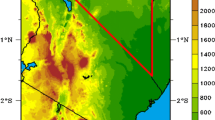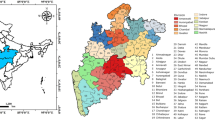Abstract
Long period data and information indicate that India faced number of droughts-like situation from colonial period. A number of indices have been developed nationally and internationally to monitor agricultural drought based on remote sensing; however, to predict the onset of agricultural drought and its evolution and monitoring in time and space in a more efficient way qualitatively, Combined Drought Index (CDI) has been developed using meteorological, land based and remote sensing observations. In this study, an effort has been made to monitor agricultural drought based on exploitation of new data, methodologies and metrics that would aid the experts to make best judgments of regional-scale drought conditions through CDI using geospatial technology. The present study has been carried out for three consecutive years of 2014, 2015 and 2016 in five states (Andhra Pradesh, Chhattisgarh, Haryana, Maharashtra and Telangana) in India at district level for southwest monsoon season when rainfed kharif crops are grown extensively across the above-mentioned states in India. CDI gives a synthetic and synoptic overview of the drought situations using a classification scheme derived from various individual indices as it has been developed to combine the strength of various indices.








Similar content being viewed by others
References
Allen R G 1998 Crop evapotranspiration – guidelines for computing crop water requirements; FAO Irrigation and drainage paper 56. Food and Agriculture Organization, Rome.
Ashok K M and Vijay P S 2010 A review of drought concepts; J. Hydrol. 391 202–216.
Daniel Hillel 1982 Introduction to Soil Physics; Academic Press, 392p.
Dipanwita D, Arnab K, Patel N R, Saha S K and Siddiqui A R 2015 Assessment of agricultural drought in Rajasthan (India) using remote sensing derived Vegetation Condition Index (VCI) and Standardized Precipitation Index (SPI); Egypt. J. Remote Sens. Space Sci. 18(1) 53-63.
Durval D, Quirijn R, Klaas M, Klaus R and Donald R 2010 General procedure to initialize the cyclic soil water balance by the Thornthwaite and Mather method; Sci. Agric. (Piracicaba, Braz.) Piracicaba 67(1) 87.
Ganesh Chandra M, Vimal M D, Niyogi S T and Govindaraju S 2016 Trends and variability of droughts over the Indian monsoon region; Weather Clim. Extrem. 12 43–68.
Handbook of Drought Indicators and Indices 2016 World Meteorological Organization No. 1173, Integrated Drought Management Programme (IDMP).
Kogan F 1995 Application of vegetation index and brightness temperature for drought detection; Adv. Space Res. 15(11) 91–100.
Martínez-Fernández J, González-Zamora J, Sánchez N and Gumuzzio N 2015 A soil water based index as a suitable agricultural drought indicator; J. Hydrol. 522 265–273.
McKee T B and Doesken N 1993 The relationship of drought frequency and duration to time scales; Eighth Conference on Applied Climatology (Anaheim, California), pp. 179–184.
Nippert J B and Knapp A K 2007 Soil water partitioning contributes to species coexistence in tallgrass prairie; Oikos 116 1017–1029.
Pai D S, Sridhar L, Rajeevan M, Sreejith O P, Satbhai N S and Mukhopadhyay B 2013 Development and analysis of a new high spatial resolution (0.25° × 0.25°) long period (1901–2010) daily gridded rainfall data set over India; NCCR Report No. 1/2013 of IMD.
Palmer W C 1968 Keeping track of crop moisture conditions nationwide: The crop moisture index; Weatherwise 21 156–161.
Rajeevan M, Bhate J, Kale K D and Lal B 2006 High resolution daily gridded rainfall data for the Indian region: Analysis of break and active monsoon spells; Curr. Sci. 91 296–306.
Sepulcre-Canto G, Horion S, Singleton A, Carrao H and Vogt J 2012 Development of a combined drought indicator to detect agricultural drought in Europe; Nat. Hazards Earth Syst. Sci. 12 3519–3531.
Sivakumar M V K and Wilhite D A 2016 Drought Preparedness and Drought Management; Manual for Drought Management, Ministry of Agriculture & Farmers Welfare, Government of India.
Svoboda M, Lecomte D, Hayes M, Heim R, Gleason K, Angel J, Rippey B, Tinker R, Palecki M, Stooksbury D, Miskus D and Stephens S 2002 The drought monitor; J. Amer. Meteorol. Soc., 1181–1190.
Thornthwaite C W and Mather J R 1955 The water balance; Climatology 8(l).
Thornthwaite C W and Associates, Centerton, New Jersey, 104p.
Todisco F, Vergni L and Mannocchi F 2008 An evaluation of some drought indices in the monitoring and prediction of agricultural drought impact in central Italy; Conference paper presented in Irrigation in Mediterranean Agriculture: Challenges and Innovation for the Next Decades, pp. 203–211.
Tucker C J, Pinzon J E, Brown M E, Slayback D A, Mahoney R, Vermote E F, and El Saleous N 2010 An extended AVHRR 8-km NDVI dataset compatible with MODIS and spot vegetation NDVI data; Int. J. Remote Sens. 26(20) 1198–4485.
Trenberth K E, Dai A, van der Schrier G, Jones P D, Barichivich J, Briffa K R and Sheffield J 2014 Global warming and changes in drought; Nat. Clim. Change 4 17–22, https://doi.org/10.1038/NCLIMATE2067.
World Meteorological Organization (WMO) 2006 Drought monitoring and early warning: Concepts, progress and future challenges, WMO No. 1006.
Acknowledgements
Authors express their thanks to Space Applications Centre (SAC), Indian Space Research Organisation (ISRO), SAC Ahmedabad for providing the reference evapotranspiration product. Authors are also thankful to Ms. Manisha Taposundare who helped in analysing the data.
Author information
Authors and Affiliations
Corresponding author
Additional information
Communicated by A K Sahai
Rights and permissions
About this article
Cite this article
Chattopadhyay, N., Malathi, K., Tidke, N. et al. Monitoring agricultural drought using combined drought index in India. J Earth Syst Sci 129, 155 (2020). https://doi.org/10.1007/s12040-020-01417-w
Received:
Revised:
Accepted:
Published:
DOI: https://doi.org/10.1007/s12040-020-01417-w




